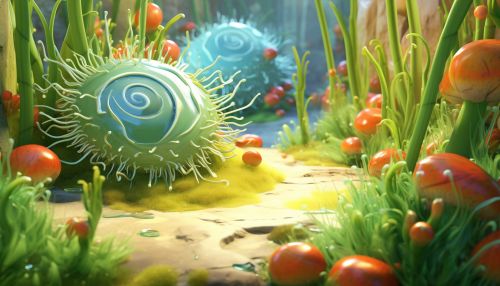Biological Mechanisms of Plant Pathogen Interactions
Introduction
Plant pathogens are microbial agents that cause diseases in plants. The interaction between a plant and a pathogen is a complex process involving various biological mechanisms. This article delves into the intricate details of these mechanisms, focusing on the pathogen's infection strategies, the plant's defense responses, and the co-evolution of both parties in this biological warfare.


Pathogen Infection Strategies
Plant pathogens employ a variety of strategies to invade host plants, including the production of effector proteins, the manipulation of plant signaling pathways, and the exploitation of plant nutrients.
Effector Molecules
Effector molecules are proteins secreted by pathogens that manipulate the host plant's cellular processes to facilitate infection. They can suppress plant immune responses, alter plant metabolism, and promote pathogen growth and reproduction. Some effectors can even mimic plant proteins to deceive the plant's defense mechanisms.
Manipulation of Plant Signaling Pathways
Pathogens can manipulate plant signaling pathways to facilitate their invasion. For instance, some pathogens can hijack the plant's hormone signaling pathways, altering the plant's growth and development to their advantage. Others can interfere with the plant's salicylic acid signaling pathway, a key component of the plant's immune response.
Exploitation of Plant Nutrients
Pathogens can also exploit the plant's nutrients for their growth and reproduction. They can secrete enzymes that degrade plant cell walls, allowing them to access the nutrients inside the cells. Some pathogens can even alter the plant's nutrient transport systems to redirect nutrients towards themselves.


Plant Defense Responses
In response to pathogen invasion, plants have evolved a range of defense mechanisms, including physical barriers, chemical defenses, and immune responses.
Physical Barriers
The plant's physical barriers, such as the cuticle and cell wall, are the first line of defense against pathogens. These barriers can prevent pathogens from penetrating the plant tissues. In addition, plants can reinforce their cell walls with lignin and callose in response to pathogen attack.
Chemical Defenses
Plants can produce a variety of chemical compounds to defend against pathogens. These include antimicrobial compounds, such as phytoalexins and phytoanticipins, and signaling molecules, such as salicylic acid and jasmonic acid, which can activate the plant's immune responses.
Immune Responses
Plants have two layers of immune responses: the pathogen-associated molecular pattern (PAMP)-triggered immunity (PTI) and the effector-triggered immunity (ETI). PTI is triggered by the recognition of PAMPs, common molecular patterns found in many pathogens. ETI, on the other hand, is triggered by the recognition of specific effector molecules, leading to a stronger and more specific immune response.


Co-evolution of Plants and Pathogens
The interaction between plants and pathogens is a dynamic process, with both parties continually evolving to gain an advantage over the other. This co-evolutionary arms race has led to the diversification of plant defense mechanisms and pathogen infection strategies.
Evolution of Plant Defense Mechanisms
Plants have evolved a range of defense mechanisms in response to pathogen pressure. These include the evolution of new immune receptors, the diversification of antimicrobial compounds, and the development of resistance (R) genes. R genes can recognize specific effector molecules, triggering a strong immune response known as the hypersensitive response (HR).
Evolution of Pathogen Infection Strategies
In response to the evolution of plant defenses, pathogens have evolved various strategies to overcome these defenses. These include the evolution of new effector molecules, the alteration of PAMPs to evade detection, and the development of resistance-breaking strains.


